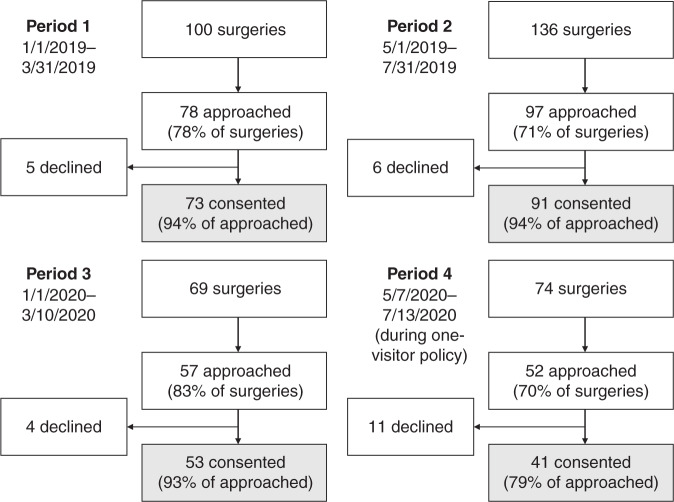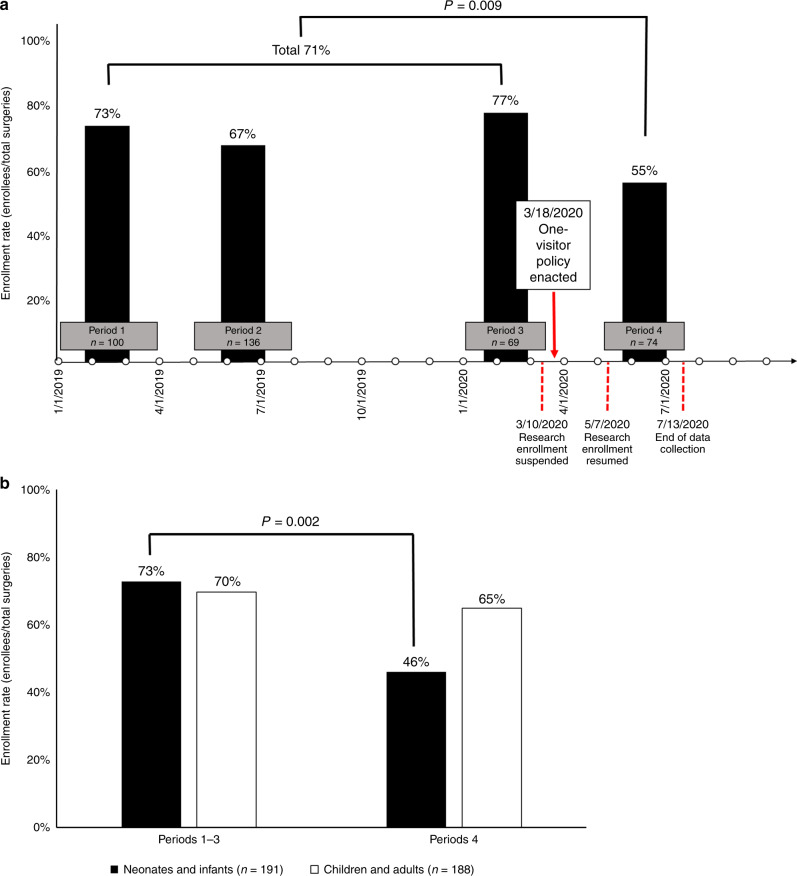Introduction
The COVID-19 pandemic has already had widespread effects on healthcare and health-related research worldwide. Early phase responses to the pandemic included restriction of clinical care and research to essential, time-sensitive and COVID-related activities in many institutions. With the re-introduction of clinical services, a number of strategies were imposed to minimize viral transmission to patients and healthcare personnel, such as strict limits on visitors/caregivers in pediatric inpatient facilities, which may have ethical implications on family-centered care.1–3 Here we investigate consent rates for a clinical research study before and after implementation of a one-visitor policy at our children’s hospital.
Methods
We conducted a retrospective review of enrollment in a clinical research study performed at an academic tertiary care children’s hospital. The parent study is an IRB-approved observational cohort study enrolling children, adolescents, and young adults undergoing congenital heart surgery since 2007.4 All patients undergoing congenital heart surgery at Monroe Carell, Jr. Children’s Hospital at Vanderbilt and subsequently admitted to the pediatric cardiac intensive care unit are eligible for enrollment, regardless of age. The parents/guardians of eligible subjects are approached for enrollment by research nurses prior to the operative procedure, either in the inpatient setting or in the clinic the day before surgery for outpatients. Of note, as an observational study, it is minimal risk, and for minors the written consent of only one parent/guardian is required. On March 10, 2020 enrollment in the study was paused due to institutional restrictions on research in response to the COVID-19 pandemic. Prior to that date, there were no restrictions on elective surgical procedures and both parents were allowed to be with the children in hospital. On March 18, 2020, a restricted visitor policy allowing only one parent/visitor for pediatric inpatients and outpatients was enacted. By May 7, 2020, elective cardiac cases had resumed and enrollment in the study began again, but the one-parent/visitor policy remained in effect.
We calculated the consent rate (number of enrollees in the study/number approached for enrollment) and enrollment rate (number of enrollees in the study/total operative patients) for historical periods [January 1, 2019−March 31, 2019 (Period 1) and May 1, 2019–July 31, 2019 (Period 2)]; the time immediately preceding the one-visitor policy [January 1, 2020−March 10, 2020 (Period 3)]; and during the one-visitor policy [May 7, 2020–July 13, 2020 (Period 4)]. The historical periods from 2019 were chosen to match the 2020 periods in order to account for any seasonal variation in surgical volume. Patients are subclassified as neonates (<31 days), infants (31 days−1 year), children (1 year−18 years) and adults (≥18 years). All comparisons were evaluated using χ2 with a two-tailed P < 0.05 indicating statistical significance. Data were analyzed using SPSS for Windows version 26.0 (SPSS Inc., Chicago, IL).
Results
The total number of surgeries for all four periods was 379, and 268 (68%) enrolled in the research study. There were 58 neonates, 133 infants, 148 children, and 40 adults. A flow diagram showing the number of surgeries, number approached, number declined, and number enrolled for each of the four periods is displayed in Fig. 1. Across all four periods, 75% of eligible subjects were approached, with no significant difference between periods (Fig. 1, P = 0.215). The consent rates (enrollees/approached) for the four periods are also shown in Fig. 1. There was no difference in consent rates in the three periods before the one-visitor policy (P = 0.98), but the consent rate for periods 1–3 was significantly higher than that for period 4, during the one-visitor policy (94% vs. 79%, P = 0.001). The overall enrollment rates (enrollees/total surgeries) are shown in Fig. 2a. There was no significant difference in enrollment rates in the three periods before the restricted visitor policy (P = 0.3), but the enrollment rate for periods 1–3 was significantly higher than that for period 4, during the one-visitor policy (P = 0.009, Fig. 2a). Among age categories, there was no significant difference in enrollment rates before (periods 1–3) vs. during (period 4) the one-visitor policy for adults and children (P = 0.583), but it dropped significantly for neonates/infants (P = 0.002, Fig. 2b).
Fig. 1. Study flow diagram and consent rates.
The number of surgeries, number of subjects approached for research, number consented, and number declined for each of the study periods is shown. The shaded boxes also indicate the consent rates for each study period (enrollees/approached).
Fig. 2. Research enrollment rates before and after a COVID-19 one-parent visitor policy in a children’s hospital.
a Timeline with study periods indicated, and proportion of congenital heart operative patients consented into research study. Overall, there was a significant drop in enrollment rates after implementation of a one-parent visitor policy. b Proportion of congenital heart surgical cases consented into research study stratified by age category. There was a significant drop in enrollment for neonates and infants (black) but not for children and adults (white).
Discussion
We observed a significant reduction in the consent rate for an observational research study in the early months of the COVID-19 pandemic and during implementation of a one-parent/visitor policy in our children’s hospital. The decrease in the consent rates was driven primarily by a reduction in consent rates for neonates and infants. It is possible that the reduced consent rate would be observed regardless of the parent/visitor policy due to the increased psychological stress of the COVID-19 pandemic alone,5 or that the changes in other policies and procedures related to COVID-19 have impacted the quality of our consent discussions. However, we did note some parents cited a desire to discuss participation with the other parent prior to consenting, suggesting the policy is responsible for some portion of the decline.
We can only speculate on why this disproportionately affected neonates and infants vs. older children whose families were approached for enrollment. It is possible that the parents of older children with congenital heart disease have prior experience with research study enrollment, and thus the parents have already discussed research study participation. Parents of older children may also have prior experience with our medical center, which increased trust and willingness to participate in research. However, the reasons for declining consent were not formally assessed by our study team.
Several questions raised by our observations merit further inquiry. The generalizability of these findings must be assessed across sites and types of research studies. Whether the decline in consent rates is due to the one-parent policy, increased stress during the pandemic, decreased trust in the medical system, and/or some other factor could be assessed by investigating a broader array of medical centers and surveying parents and guardians specifically about these issues. The best approaches to mitigate these effects, which may persist well into the future, may be assessed by trials of alternate consent methods (e.g. electronic consent), various methods of messaging to patient families (e.g. video calls, print materials, etc.), and interactions with various team members (e.g. principal investigator, study nurse, patient advocate, etc.).
As clinical research resumes in the setting of an ongoing pandemic, certain precautions are required. Restricting visitors to inpatient facilities where critically ill and immunocompromised patients are cared for may continue to be necessary for the safety of both patients and staff. One unintended consequence appears to be reduced enrollment in clinical research, disproportionally affecting neonates and infants. This interference with carrying out clinical research could have several harmful consequences to different populations including: (1) under-enrollment, which undermines the contributions of the patients who do participate; (2) delay (or eventual failure) of valuable research studies that have the potential to inform and improve care for future patients; (3) expense of research budgets due to added effort of enrollment; (4) interference with performance of research, leading to metrics necessary for successful academic careers.6 Pediatric researchers, their funders, and academic institutions must be mindful of these issues in order to successfully complete pediatric research studies during and after the COVID-19 pandemic.
Acknowledgements
This work was supported in part by the National Institutes of Health grants HD084461, GM132204 and TR002243. The funding agency had no role in the study design, the collection, analysis, and interpretation of data, the writing of the report, or the decision to submit the manuscript for publication.
Author contributions
S.L.V.D. and P.J.K. conceptualized and designed the study, carried out the analyses, drafted the initial manuscript and reviewed and revised the manuscript. A.H.S., D.P.B., S.M.M. and K.C. provided data and critically reviewed the manuscript for important intellectual content. All authors approved the final manuscript and agree to be accountable for all aspects of the work.
Competing interests
The authors declare no competing interests.
Consent statement
The parent study is an IRB-approved observational study that obtains written informed consent consent from participants/guardians.
Footnotes
Publisher’s note Springer Nature remains neutral with regard to jurisdictional claims in published maps and institutional affiliations.
References
- 1.Virani AK, et al. Benefits and risks of visitor restrictions for hospitalized children during the COVID pandemic. Pediatrics. 2020;146:e2020000786. doi: 10.1542/peds.2020-000786. [DOI] [PubMed] [Google Scholar]
- 2.Vissers, M. F. J. M., Cohen, A. F., van Gerven, J. M. A. & Groeneveld, G. J. The impact of the global COVID-19 pandemic on the conduct of clinical trials. Return to normalcy by considering the practical impact of a structured ethical analysis. Br. J. Clin. Pharmacol. 10.1111/bcp.14480 (2020). [DOI] [PubMed]
- 3.Mahoney AD, et al. Impact of restrictions on parental presence in neonatal intensive care units related to coronavirus disease 2019. J. Perinatol. 2020;40:36–46. doi: 10.1038/s41372-020-0753-7. [DOI] [PMC free article] [PubMed] [Google Scholar]
- 4.Fuchs SR, et al. Incidence and effect of early postoperative ventricular arrhythmias after congenital heart surgery. Heart Rhythm. 2019;16:710–716. doi: 10.1016/j.hrthm.2018.11.032. [DOI] [PMC free article] [PubMed] [Google Scholar]
- 5.Patrick, S. W. et al. Well-being of parents and children during the COVID-19 pandemic: a national survey. Pediatrics.10.1542/peds.2020-016824 (2020). [DOI] [PubMed]
- 6.Weiner DL, Balasubramaniam V, Shah SI, Javier JR. Pediatric Policy Council. COVID-19 impact on research, lessons learned from COVID-19 research, implications for pediatric research. Pediatr. Res. 2020;88:148–150. doi: 10.1038/s41390-020-1006-3. [DOI] [PubMed] [Google Scholar]




